Graduating to a new ride can be fun, whether moving up to a bigger bike or simply choosing your favorite color. Some models receive key changes but are those enough to win our annual comparison? Or are the unchanged bikes good enough to stay on top? Find out now.
2023 Shootout Video
Photography by Kit Palmer
Think back to your last graduation day. Masters, bachelor’s, military, high school, whatever. Some of those in the crowd are the same as they’ve always been. Others have changed drastically throughout the years. Class presidents, class clowns, jocks, nerds and those that fall between the cracks. That’s how this year’s class of 250cc four-stroke motocrossers is. As they get ready to walk across the stage or out of the dealership doors, three of the six-machine lineup see dramatic changes, while the other half maintain their mid-generation stance.
The Yamaha is essentially the class president, the golden child, the teacher’s pet. While unchanged for ’23, this current generation YZ, and even the ones before, have seen shootout success for the last few years, and another year on top wouldn’t come as a surprise. However, the KTM and Husqvarna see ground-up revisions for the 2023 model year. The Kawasaki is also heavily updated while still riding on the same platform. The Honda CRF250R and the GasGas MC 250F come to their graduation ceremony with no changes from the previous year.
Every bike was ridden just as you’d find them straight off the showroom floor. Stock tires, grips, the whole deal. The only “modification” we made was the DeCal Works number-plate backgrounds, just to make the bikes pretty. Any adjustments made during our test required no special tools unless it came with the bike purchase. Engine mapping and suspension tuning always remained within what was already available on each motorcycle.
The Class of 2023
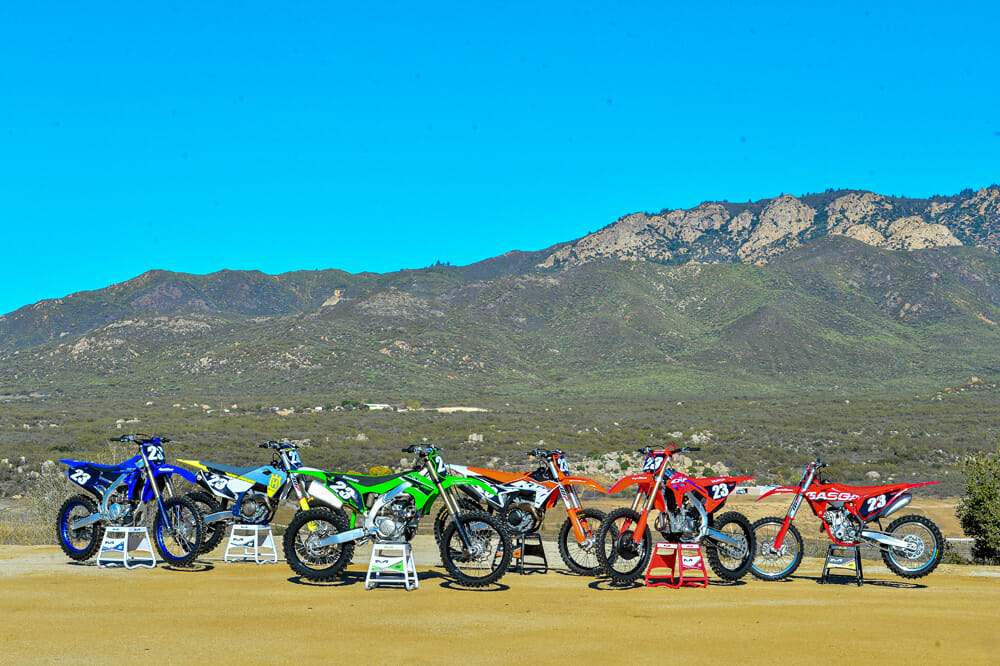
2023 Yamaha YZ250F ($8599)
Wet weight – 235 lbs. (claimed)
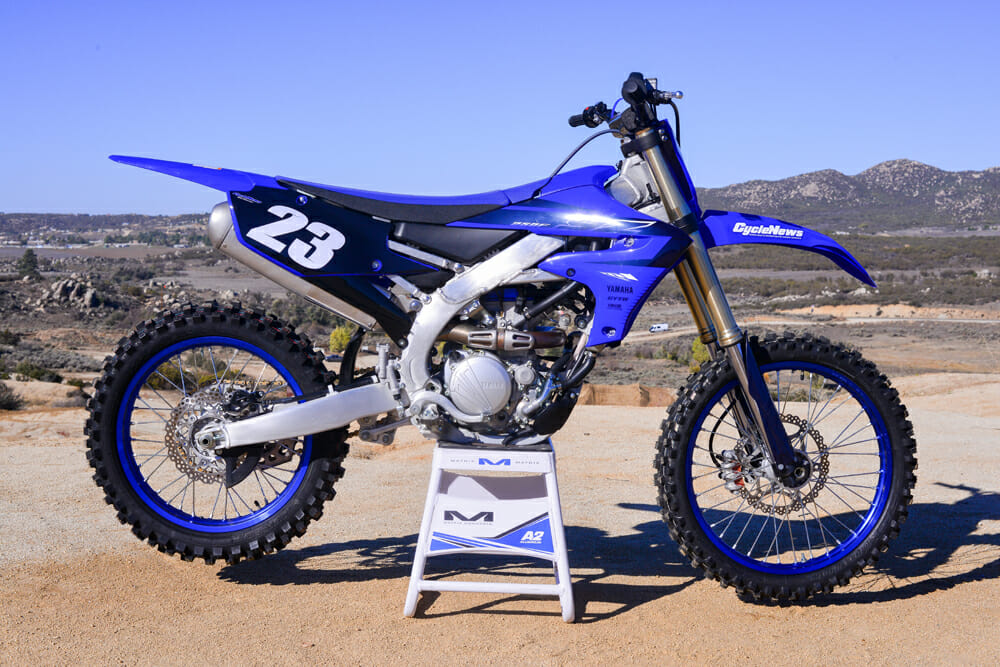
Last year we said the Yamaha YZ250F was unchanged, and for the most part, it was. Minor updates like a new rear-wheel setup with a wider rim, a new spoke pattern, and a wider Dunlop tire were the only changes. This year though, the only update this bike receives is a set of bold new graphics. After three years of winning the Cycle News shootout, does it really need anything changed? Maybe, maybe not. The blue crew is back again, looking for a full-ride scholarship to the podium’s top step.
2023 Husqvarna FC 250 ($10,099)
Dry Weight – 223 lbs. (claimed)
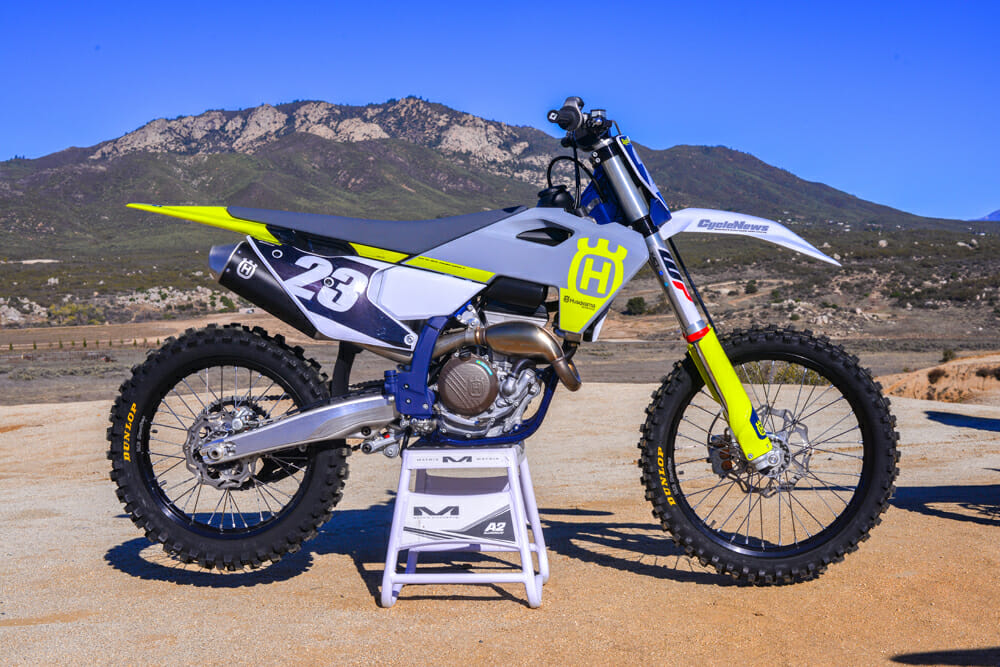
The Husqvarna FC 250 is the first of two bikes that enter a new generation for 2023. It gets an all-new frame, motor, and electronics package strikingly similar to its KTM brethren. In doing so, it’s put on a few pounds from the previous year. The Husky has also changed from white to gray and sits 10mm lower than the KTM. While the FC has always been closely related to the KTM, this model year is the most similar they’ve ever been. ProTaper handlebars, slightly different plastics, and lower suspension are the main differences that set the Husqvarna apart from its Austrian relative.
2023 Kawasaki KX250 ($8499)
Dry Weight – 227.6 lbs. (claimed)
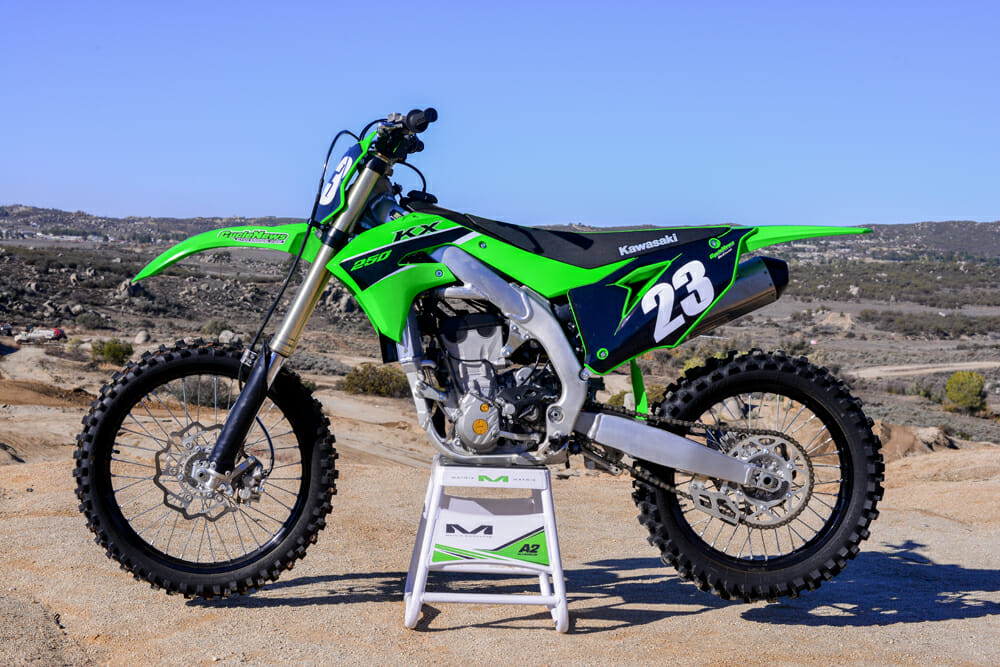
The Kawasaki KX250 might appear unchanged: Dig a bit deeper, though, and you’ll see quite a few updates from the 2022 model. Engine performance, mainly low-to-mid-range power, was the main focus for this year’s KX. The green machine received a longer exhaust header, a straighter downdraft intake, and a repositioned injector in the throttle valve. With a dual injector system, the second upstream injector (the one closest to the airbox) has been relocated from the top of the air intake to the bottom for a more efficient shot into the engine. Aside from that, the Kawi is more or less the same strong contender it’s been for the past few years.
2023 Honda CRF250R ($8199)
Wet Weight 232 lbs. (claimed)
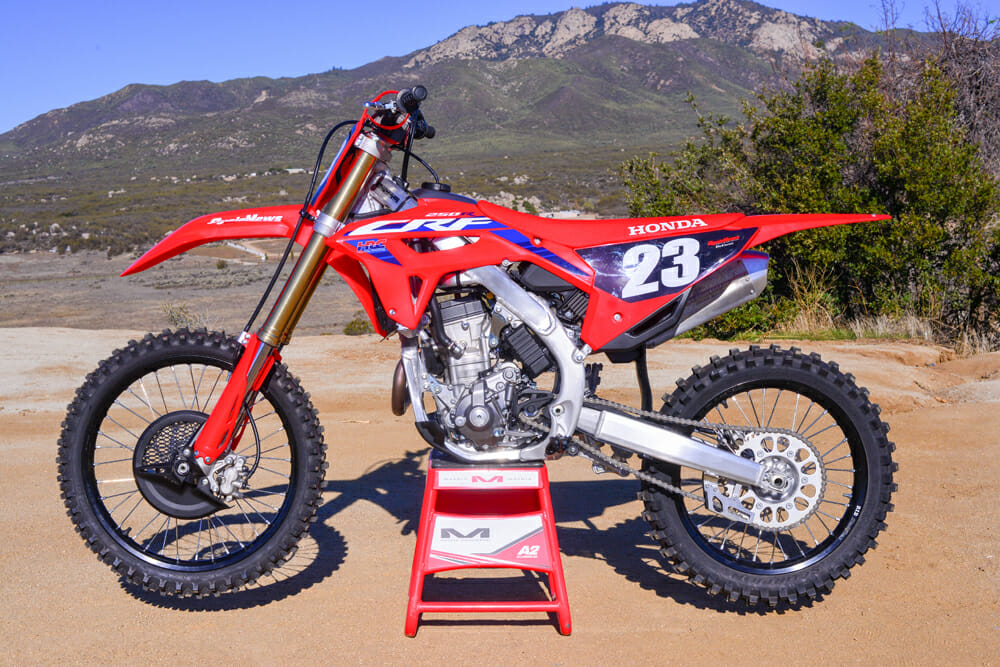
After a ground-up redesign in 2022, Honda’s CRF250R sees no updates besides graphics for the 2023 model year. In last year’s test, the newly changed CRF landed on the podium in third place. A rider-friendly cockpit, Showa suspension, Pirelli Scorpion tires, a cable-operated clutch, and a three-mode map switch highlight the Honda’s spec sheet. Sure it’s still lighter, smoother, and all around better than the previous generation, but without any changes for this year, we’re still determining if it will bump up in our overall rankings. Jett Lawrence raced this bike to an outdoor championship, and Honda’s hoping to do the same thing here.
2023 KTM 250 SX-F ($9999)
Dry Weight 222 lbs. (claimed)
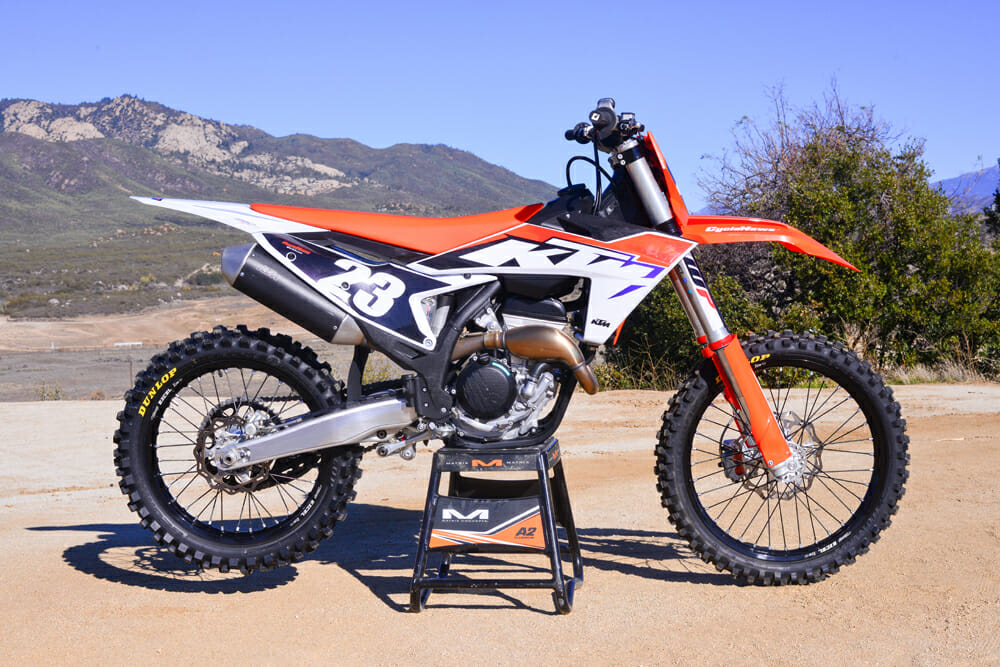
The KTM 250 SX-F is the only other all-new bike in the class. A new frame, engine, swingarm, bodywork and electronic suite are on the short list of updates to the Orange Brigade’s flagship 250 motocrosser. These improvements were all aimed at centralizing mass while also improving power and rider comfort. In doing so, the KTM has packed four extra pounds of claimed weight and lost its definite spot as the lightest bike in the class. Selectable mapping, traction control, Brembo brakes, and even a quickshifter are all race-ready features that look to put KTM at the top of the class.
GasGas MC 250F ($9199)
Dry Weight 218 lbs. (claimed)
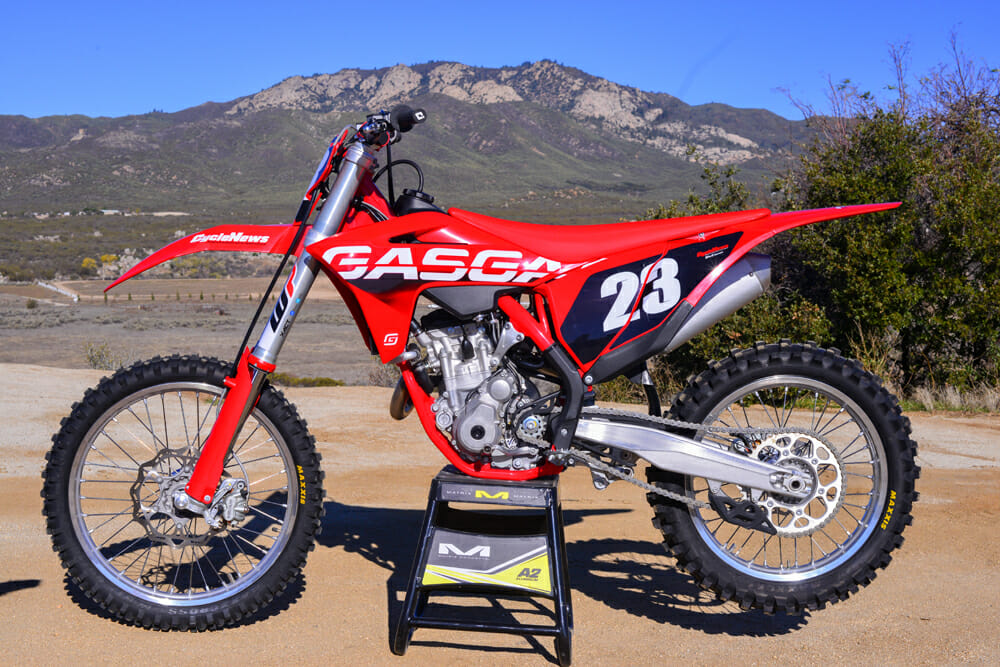
The GasGas MC 250F is the third and final bike in the Austrian lineup. The second red machine is positioned as the more affordable and “more fun” brand compared to the KTM or the Husqvarna. To save on overall price, the MC 250F comes equipped with cast triple clamps and non-branded aluminum handlebars and does not have the option to change engine maps. The biggest difference is that the GasGas also rides on the previous KTM/Husqvarna chassis and engine. The other two Austrian bikes have left the MC 250F behind as they enter a new generation. While the others pursue a new setting, the lighter and more simplistic approach from GasGas could be enough to shake up the order.
What About the 2023 Suzuki RM-Z250?
Suzuki elected not to participate in our 2023 250cc Four-Stroke Motocross Shootout. We certainly wanted to include it but we also wanted to respect Suzuki’s wishes.
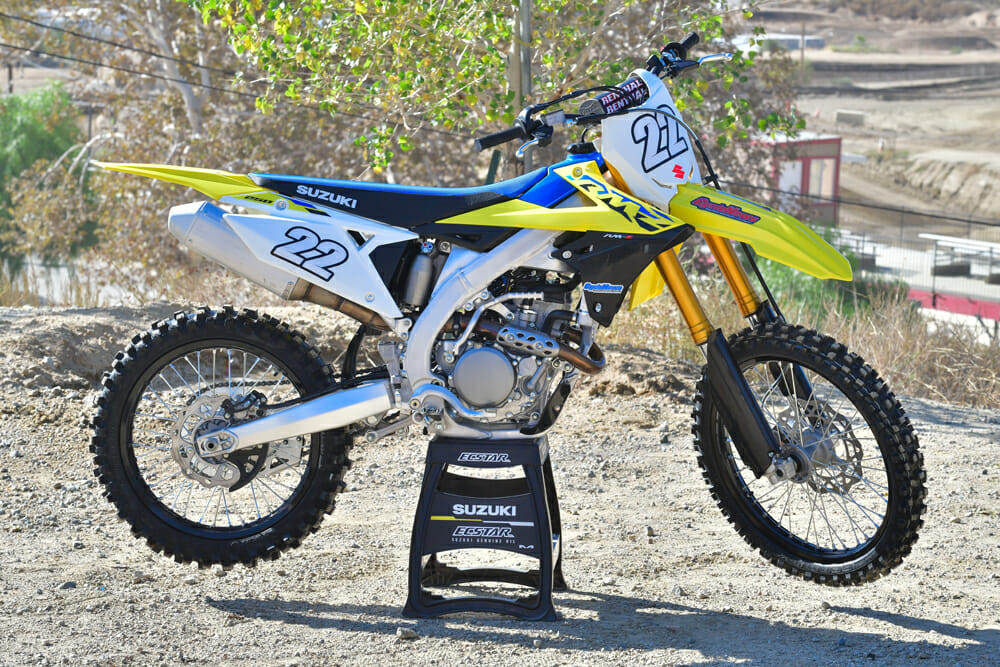
It’s easy to criticize the RM-Z250 on paper. It has two major strikes against it right off the bat—compared to its rivals, the Suzuki is the heaviest on the scale and the only 250F without an electric start. By those two metrics alone, we already know where it rates. On the track, factor in its mellow power delivery and harsh suspension, well, let’s just say it doesn’t attract hard-core racers anymore.
This doesn’t mean the long-in-the-tooth RM-Z is a bad bike, it’s just not as competitive out of the crate as it once was compared to its ever-evolving class rivals. The RM-Z still has a great platform and is the least expensive at $7899. In reality, the RM-Z is just a suspension re-valve and a full exhaust system away from being in the show.
Stock for stock, it is being left further behind with each model year. But if you’re looking for an ideal platform from which to build your race weapon—and you don’t need the button—you can still consider yellow. You can always improve power. You can always re-valve suspension. And there is that razor-sharp handling and bulletproof reliability the RM-Z250 platform is known for.
The Suzuki might not be for everyone, but it still has a niche, especially for those not big into racing but still like to hit the track.
Sixth Place
GasGas MC 250F
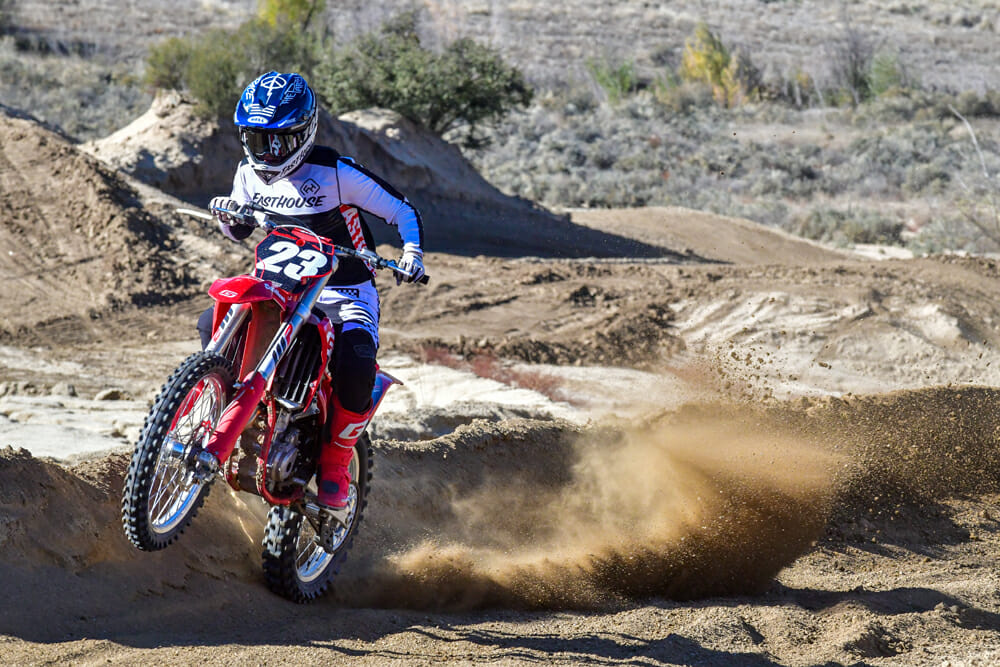
At the end of the day, one of these bikes must round out the list. That’s just the nature of the beast. Unfortunately, for this year’s class, it’s the GasGas MC 250F. The last of the Austrian machines is also the one with the lowest MSRP; as you’d guess, it offers the fewest choice parts. It’s still a fun bike to ride, and it doesn’t hinder anyone’s abilities; it just falls short when ranked against the rest of the front runners.
When the GasGas is presented alongside the Husky and the KTM, you immediately see what it’s lacking. Isn’t that the first thing we ask when we see these in the showroom? “So, what doesn’t this one have?” No engine map selector, no traction control and no quickshifter. Right out of the gate, it’s an uphill battle for the Austrian bike of limited bells and whistles to compete among its own family, let alone the entire pack.
Where the GasGas excels is in the motor department. The engine in the MC 250F is the same as the previous generation KTM and Husqvarna. For the GasGas, that means it’s technically unchanged, but again, placing these side-by-side is where the differences stand out. The motor is free-revving all around and possesses a more light-switch feeling when compared to the other Austrian power plants. It feels light and comes alive with a 125-esque personality in the mid-to-top end rage. Our faster riders praised the bike for its fun-loving engine, but some of our novice-level riders ranked it lower due to its on-or-off nature.
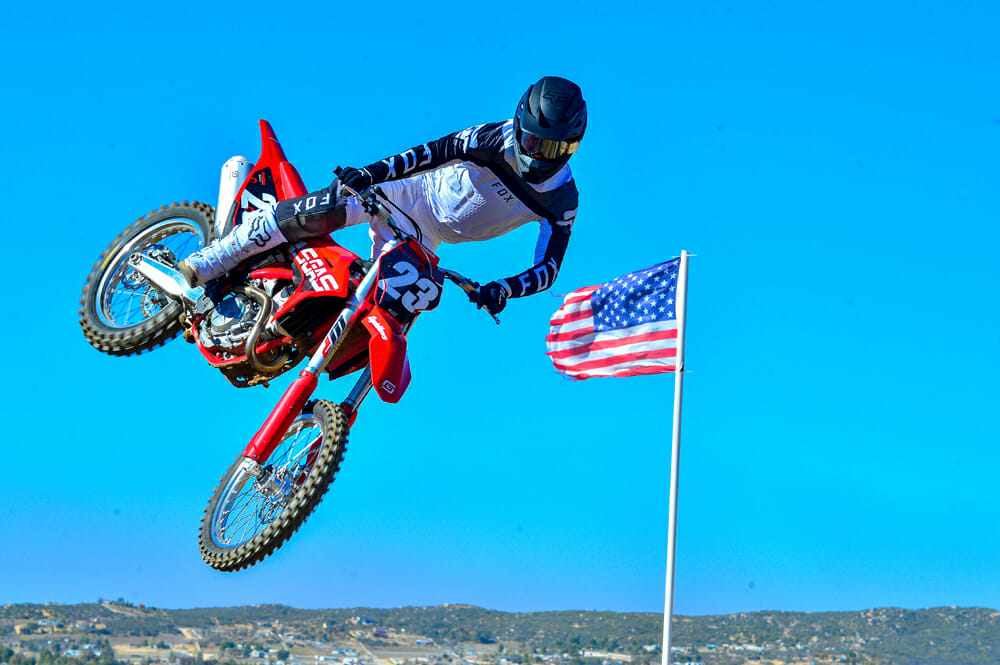
Suspension is what ultimately holds the GasGas back. All our riders noted that the softer settings on this bike were comfortable but, in turn, made it feel too playful. The squishy setup is sometimes a good thing, especially for our riders who favored the vet track instead of the main track. The GasGas seemed to eat up the choppy acceleration bumps with ease but felt too soft when pushed on the main track by our more-aggressive testers. The faster guys kept playing with air pressure in the fork to get that perfect setting. In the end, they couldn’t charge the track on the GasGas like they could on the other five bikes.
The GasGas maintains that Austrian quality that we’ve come to like within the KTM Group’s brand of bikes. Brembo brakes, a hydraulic clutch, and the steel frame were all areas of praise. The frame alone is an advantage on the faster, more wide-open tracks as it holds traction in flat turns noticeably better than its aluminum competitors.
We can look past the cast triple clamps and “un-branded” bars as they don’t interrupt the comfortable and neutral cockpit on the GasGas. But when ranked against the other five bikes in the class, the GasGas falls just a hair short. Less aggressive riders will likely favor this bike, and saving $800 compared to the KTM is a strong plus for the GasGas. Putting those savings towards add-ons like the map switch, handlebars and an exhaust would bump this bike up a notch.
Fifth Place
Honda CRF250R
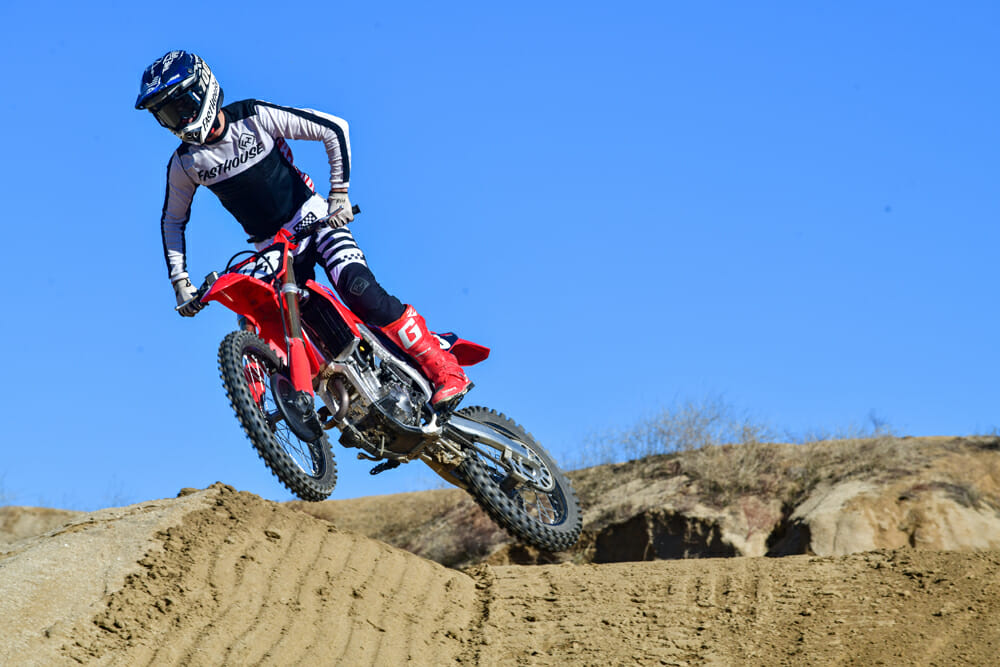
We did not see this one coming. Last year we were impressed with the then-new CRF250R, and it ranked third in our overall standings. This year though, the red ride finds itself shuffled toward the back of the pack. Here’s why.
The Honda is stiff. Sharp and precise, yes. Forgiving, no. This bike excels when ridden fast, and the faster riders found it held up well under harsh landings and higher-speed sections. Our slower and/or lighter riders, though, not so much. The rigid chassis allows the rider to make sharp turns with pinpoint accuracy and charge through jumps with little to no effort. Switching lines mid-section on the Honda is an easy task. This bike would likely top the charts on a tighter, jumpier circuit, but the two tracks we chose, Glen Helen and Cahuilla Creek, are both geared as a more national-style layout. Unfortunately for the CRF, these conditions weren’t ideal enough for the top step of the box.
After playing with the suspension on the Honda, some of our riders found a more comfortable setting. Opening the compression and rebound on the fork was the trick across the board. This opened up the suspension function and allowed the bike to have a freer feeling, especially as the track grew rougher. Riders who rode this bike first had almost nothing bad to say about it, but opinions differed once they took it out late in the day on a beat track.
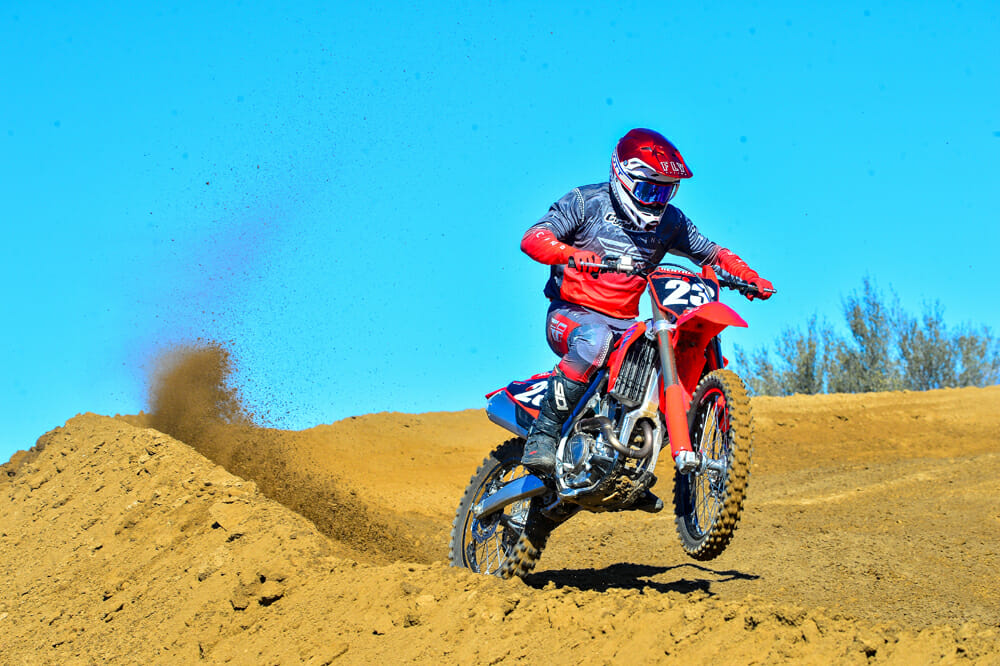
The engine package is undoubtedly the Honda’s strongest asset. All our test riders praised the CRF250R’s motor for its friendly nature and overall rideability. The three maps on the Honda are significantly different from each other and offer ride modes for various ability levels or track conditions. The standard and the mellower settings (map two) were perfect for our vets and novices, while the more aggressive setting (map three) was the go-to choice for the intermediates and pros. Like we said last year, the bottom- to mid-range power is noteworthy, and riders can enjoy a solid pull through the rpm range with a hearty dose of over-rev from the red ride. We like this engine.
In the ergonomics department, nearly all of our riders ranked the Honda first. The neutral layout makes it instantly comfortable. The rounded seat, bar position and overall rider triangle are strong pluses for the CRF. Narrow radiator shrouds let the rider cut tight turns and feel glued to the bike.
We understand multiple factors can play into these switch-around rankings. Track conditions, track prep, rider preference, ability, etc. Could this bike have won on different tracks or with different riders at the helm? Maybe. Or could it win if we spent a week fine-tuning every detail? Perhaps. But for this year, numbers are numbers, and the Honda’s overall GPA has dropped a few points. It graduates, leaving some room for improvement.
Fourth Place
Husqvarna FC 250
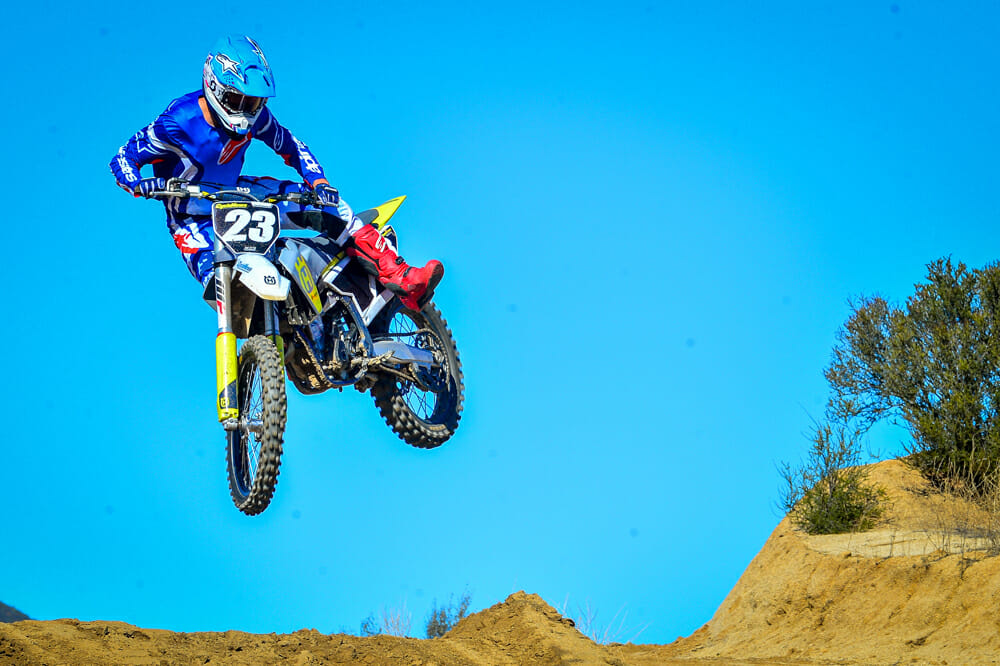
Finishing just off the podium is the Husqvarna FC 250. Despite being all-new, this bike finds itself in fourth place for the second year in a row. The Husqvarna received contrasting reviews which ultimately lowered its (no pun intended) overall ranking.
Let’s start with the good. The FC 250 is like a crouched tiger, sitting in the attack position and ready to pounce on its prey. The new-gen Husky still maintains that premium fit and finish of the Husky we’ve come to know. Simply put, it just feels like a well-made machine.
The polarized feedback on this bike is all suspension. At the surface level, 10mm doesn’t seem like a big difference. What it translates to are the seat height and actual suspension travel. The Husqvarna’s seat height is three-quarters of an inch lower than the KTM, while the suspension travel is five and seven millimeters shorter for the front and rear, respectively. This also means the Husky sits about a quarter of an inch lower to the ground. Again, it doesn’t seem like much until you take the bike out on the track.
Hitting any flat turn is where these slight differences really add up. The lowered character of the bike makes the chassis feel Velcroed to the ground. Combine that with the maneuverability of the steel frame, and the entire package feels smooth and controlled. The stability of the Husky was liked by every rider, especially in the less-rutted conditions of Cahuilla Creek.
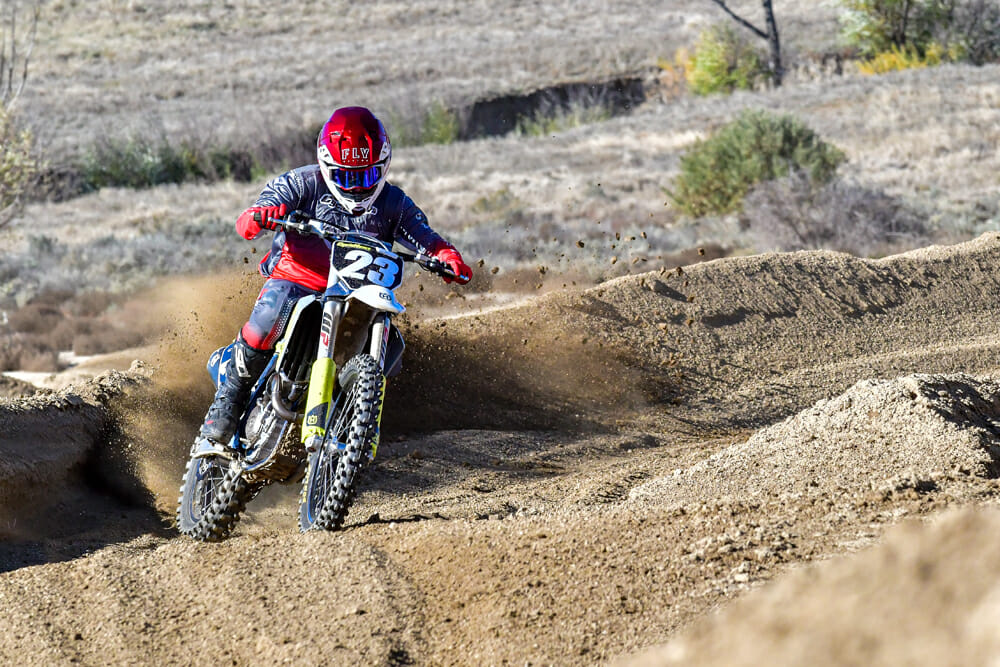
The Husky’s WP suspension continues to improve, and everyone was impressed with the strides made by their Xact air fork. A few of our riders hadn’t been on the air system in some time and were surprised at the functionality and lightweight feeling of the front end. The small bump absorption is most improved, and that former vague feeling at the front wheel is virtually gone. There is a good feel now. Yes, the air fork still requires a little more work in setup, but the tool-less clicker adjusters make trackside adjustments a whole lot easier.
The Husqvarna also received a new engine for 2023. As you’d expect, the Austrian engines require the least number of shifts per lap and let the rider get every last usable rev before hitting the limiter. Even with that extended mid to top, the Husky maintains this velvety smooth roll-on that everyone noted. The connected power delivery fits seamlessly with the supple chassis, making this bike one of the most controlled in the group.
Another stark division was the traction control and quickshifter. Half of our riders are on the “must-have” side, while the other half don’t want them on at all. The traction control was used more as the track dried out late in the day and can be useful in rainy conditions. The quickshifter took more getting used to and was only deemed necessary during starts. Unless the bike is wound out and knocking on the rev-limiter, using the quickshift option can be like short shifting, which ultimately drops it down into a less-than-ideal rpm range.
What lowered the Husky in our rankings was the lowered suspension. This received praise from our shorter riders, but the taller ones dropped it in the rankings saying they felt too cramped in the cockpit. Pair that with the highest price tag and the FC 250 is stuck in the fourth-place niche.
Third Place
Kawasaki KX250
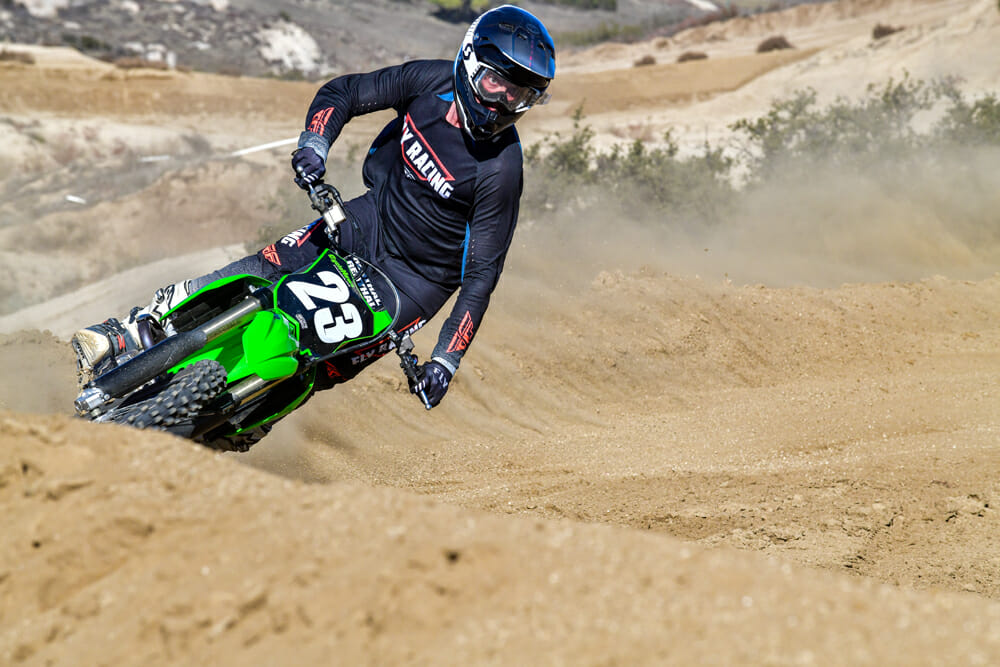
The Kawasaki KX250 sees the biggest improvement in terms of moving up in the shootout rankings. Last year, it rounded out our list in sixth place, but this time around, the KX jumps all the way up to third. We attribute this mainly to its potent new engine package, which was heavily emphasized for this model year.
This generation KX was already praised for its strong top end but lacked in the bottom to mid ranges. Now, the ’23’s updated engine results in a hearty pop off the bottom and carries a nice transition through the midrange of the power. That feeling continues from the midrange to top-end, and the bike doesn’t require a bunch of intermittent shifts to get you from section to section. Instead, gears two and three seem much longer and more usable. All but one of our test riders opted for the more-aggressive mapping coupler because it brought the motor up to par with the well-rounded Yamaha. The high-revving green machine now has more down low, which makes it easier to link sections together or get out of that tight inside line.
At one point, it looked like the Kawasaki could take the whole cake, but small inconsistencies among our testers’ ability levels dropped it a few points. The suspension and chassis were an area of discussion back in the pits. The KYB suspension is mostly unchanged, save for updated clicker specs. Kawasaki now recommends 100mm instead of 105mm of sag out back to balance out the stiffer front fork settings. This creates a stiffer feeling all around, and while it worked well at the model introduction earlier this year, we were a bit weary of how it would perform on more wide-open tracks like our shootout tracks, Glen Helen Raceway and Cahuilla Creek. The stiff nature of the Kawi makes it sharp when it comes to handling or picking a rut, but it rides a fine line between being too harsh later in the day. It’s not that the bike is overly hard to ride, but it took more time to find a good spot on the Kawi than on the two bikes that beat it. With most of our riders in the 150/180-pound range, they added a little more sag and opened up the fork to find that improved comfort.
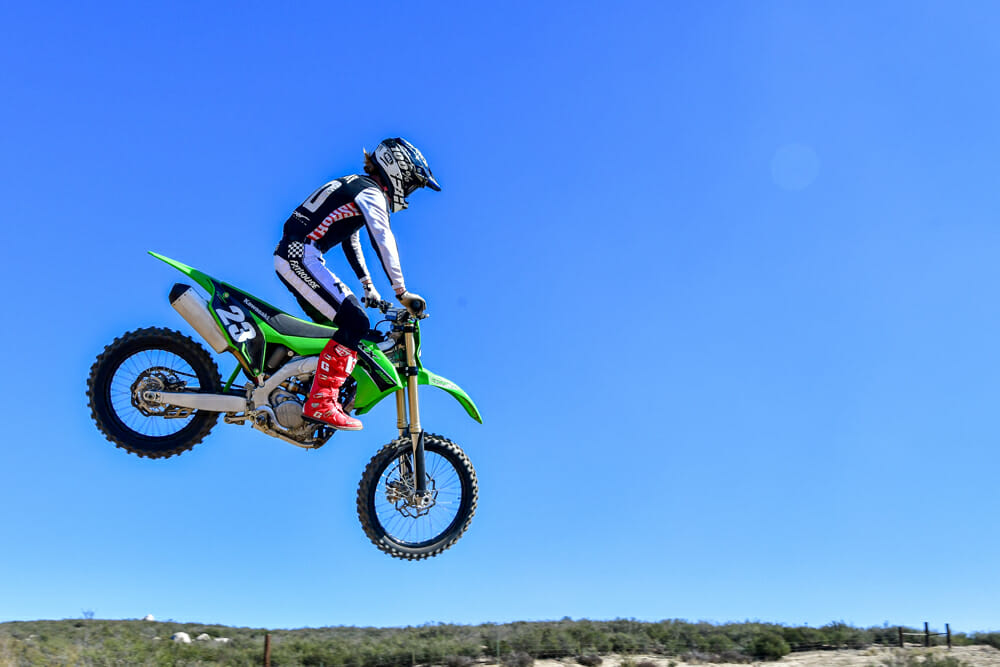
The KX’s ergos are among the best. A nice neutral setup with adjustable handlebars and footpeg mounts made it comfortable and adaptable for everyone in our group. It feels like a standard Japanese motorcycle—wide pegs, thin radiator shrouds, and that familiar squared-off seat. The clutch and brakes worked as expected, too, but they weren’t anything to write home about.
Last year the Kawi fell a few spots due to its overall fit and finish feeling a bit subpar, and the same thing happens here when we get to the nitty-gritty. The engine is on the raspy, loud side, the levers feel thin and cheap, and we all know about the Kawasaki chain guides. You’re likely to replace these parts anyways, and they’re small things to complain about, but when it comes to the top of the class, they must be mentioned.
Second Place
KTM 250 SX-F
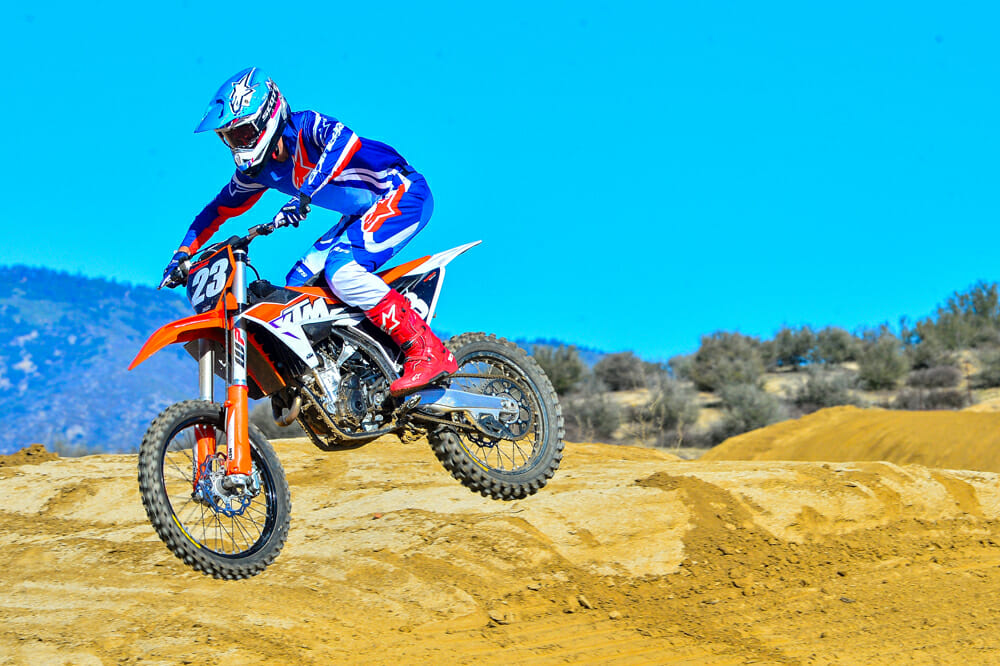
Second place goes to the KTM 250 SX-F. Despite being all-new, the KTM finds itself in the bridesmaid position for the third year in a row. It does take top honors for the fleet of Austrian bikes but falls just a few points short of the Yamaha.
KTM’s Ready To Race mantra lives true for the SX-F. This is the second all-new machine in this year’s lineup and arguably the most noticeable. The updated engine in the KTM gives you the best of both worlds. Our novice riders felt the bike’s liveliness, while the faster guys praised its overall rideability in all conditions. Even in the more-aggressive map two, it might be slightly down on raw power from the Yamaha or even the Kawasaki, but its smooth delivery gets you up to speed in a hurry. Wearing a blindfold, it can be hard to tell the Husky from the KTM based on their engines alone, but the SX-F does have a touch more pep than the FC. As we said with the Husqvarna, the traction control and quickshift are nice options but not absolute necessities in our book.
The KTM’s chassis has always been a favorite, and this year is no different. The new steel frame, without the “backbone” shock mount, favored the faster tracks while still maintaining agility in some of the tighter turns. The bike still feels light despite gaining weight from last year. That lightweight feeling we’ve come to know from the KTM is still there, but the “extra” weight makes the bike feel more planted to the ground. It’s amazing how different the ride experience is from the Husky to the KTM with that 10mm change resulting in about three-quarters of an inch at the seat height. The orange bike doesn’t feel as low to the ground, and our riders thought they could charge jumps and other obstacles harder than on the Husqvarna.
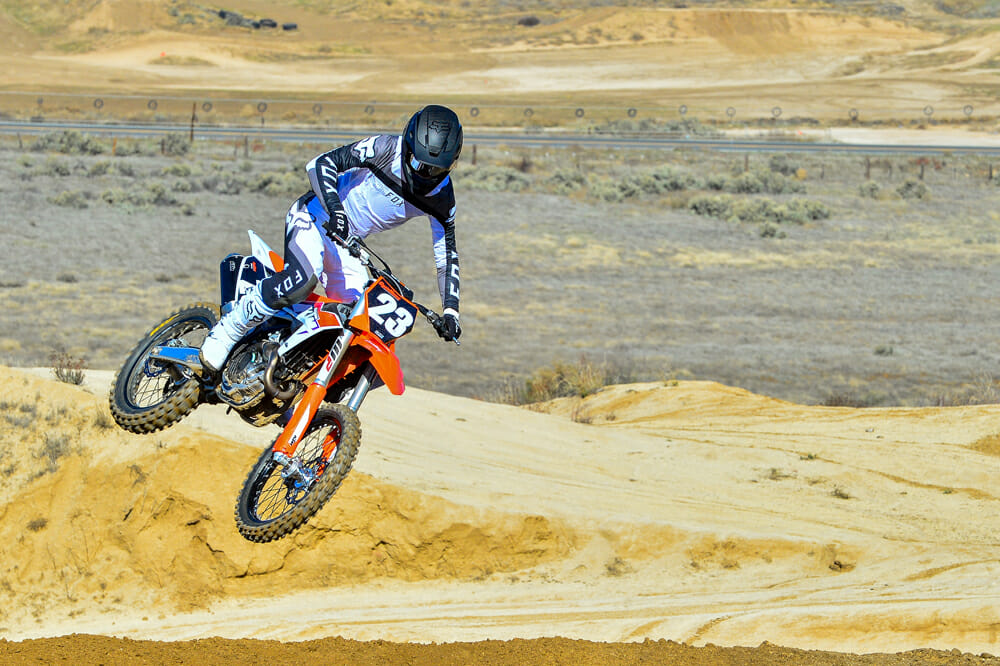
The KTM’s suspension continues to improve, but not enough to get it onto the podium’s top step. New trampoline valves and improved bottoming resistance in the WP Xact fork are lightyears better than the air fork a few years ago, but it still doesn’t have that coil spring feel we prefer. With a pneumatic coil spring up front, the whole front end feels light and nimble at the handlebars. This is a huge plus early in the day, but it can feel harsh as the track wears out. You must stay on top of the air pressure, just like tire pressure, if you really want to fine-tune the KTM’s front end. Not a huge deal if you’re willing to do it.
The KTM beats the rest of its Austrian classmates due to the overall comfort that most of our testers enjoyed.
First Place
Yamaha YZ250F
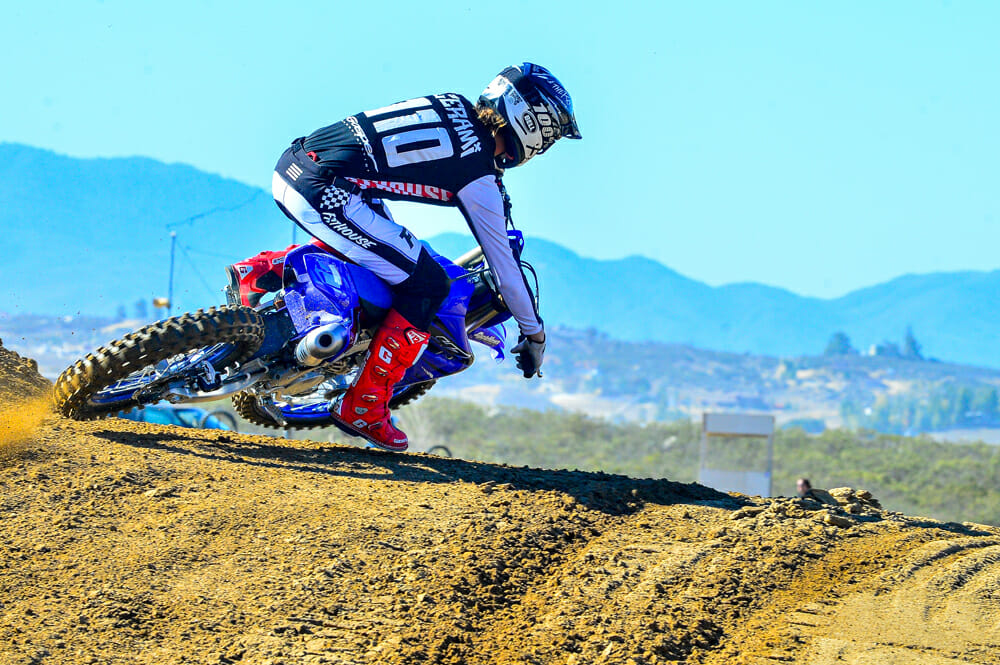
Did someone say four-peat? No updates were needed for this year’s Yami as a fully unchanged machine still stands over the competition. By a nearly unanimous decision, the Yamaha YZ250F takes the win and graduates at the top of its class yet again for 2023.
Simply put, the Yamaha is the easiest to ride—on any track, at any time, and with any riding ability. All the riders raved about this bike, and it didn’t get scored outside the top three by anyone in our group. The YZ’s engine holds some magical recipe that allows it to make power at the top of the rev range or when it’s being bogged down. The novice riders felt comfortable leaving the bike in third gear for the entirety of the track and roll corners with good speed. On the other end of the spectrum, the faster expert-level testers could ring the bike out and use every cycle of over-rev to their advantage. The ability to be lazy or aggressive on this bike is unmatched.
Building on the engine character, we must talk about the mapping capabilities of the YZ. The Power Tuner phone app makes switching maps as easy as sending a text, and the differences between the “light on” and “light off” can be dramatically different. During one moto, the Yamaha techs uploaded a map with little to no engine braking and one with heaps of over-rev. Do a few laps in each setting, and it felt like you were riding two completely different motorcycles. It’s like being a kid and growing into a bike; owners can alter power characteristics as their confidence and ability increase. Almost all the other bikes have switchable maps nowadays, but none are as versatile or as tunable as the Yamaha.
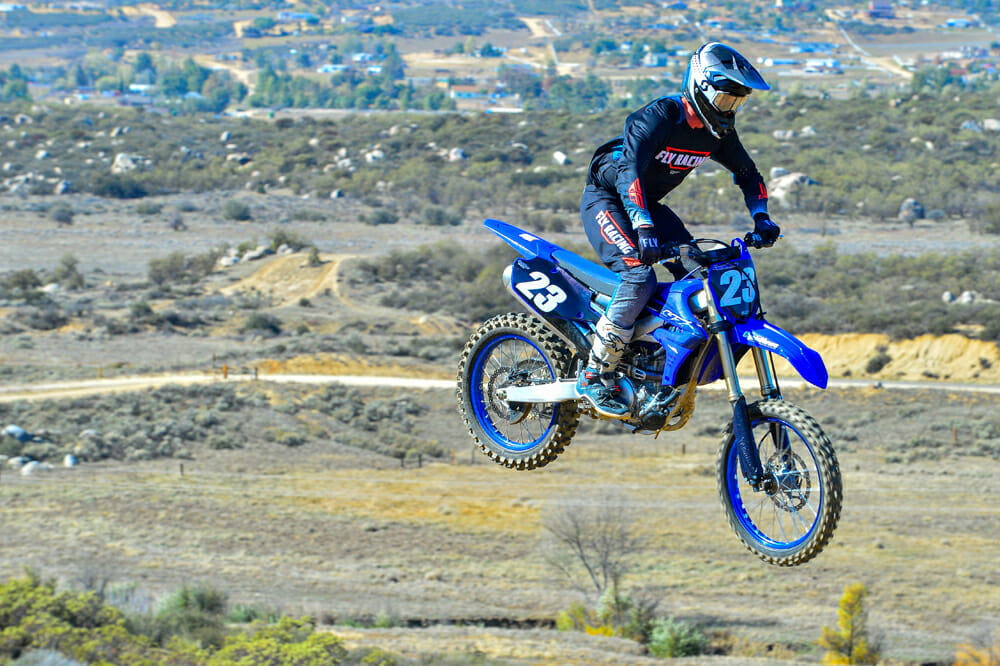
The suspension guys at Yamaha again can practically do no wrong. The KYB SSS fork is the best in class, right out of the box. Small bump absorption and big hits are soaked up without the fear of getting bucked off. Some other bikes feel like you must be heavier or faster for them to work right, but the Yamaha allows you to have fun regardless of weight or ability. One rider summed it perfectly: “There’s no other bike I’d rather be on after 2 p.m. than the Yamaha.”
If we had to nitpick the YZ250F, it would be the same things you’ve already heard. Yes, the front end feels wider than some other bikes. You sit more “in” this bike than “on” it. And louder than the rest. But, the performance positives outweigh all these negatives.
Conclusion
You really can’t go wrong with any one of these bikes. But we can confidently say that you’ll go the least wrong with the Yamaha. And when it comes to the Yamaha, we heard this said by our testers more than a few times: “If this was my only bike, I’d be so pumped.” Hands down, the Yamaha wins again.
The other five bikes in this comparison are all very capable motorcycles. It’s only when you ride them back to back to back do you notice any flaws or hiccups. They need more dialing-in time compared to the more refined Yamaha—the best bike when it comes to just getting on and going.
The Yamaha YZ250F, once again, walks across the stage as the valedictorian of the class of 2023. CN
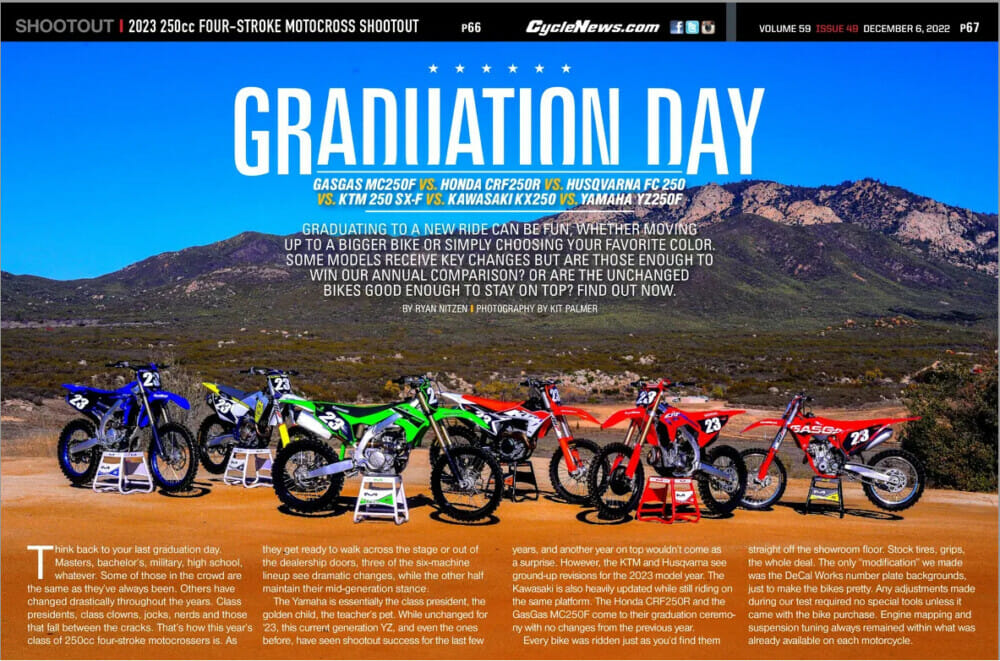
Click here to read the 2023 250cc Four-Stroke Motocross Shootout in the Cycle News Digital Edition Magazine.
Click here for the latest Cycle News Motocross bike reviews and news.
Click here for more GasGas motorcycle reviews and news.
Click here for more Honda motorcycle reviews and news.
Click here for more Husqvarna motorcycle reviews and news.
Click here for more Kawasaki motorcycle reviews and news.
Click here for more KTM motorcycle reviews and news.
Click here for more Yamaha motorcycle reviews and news.
